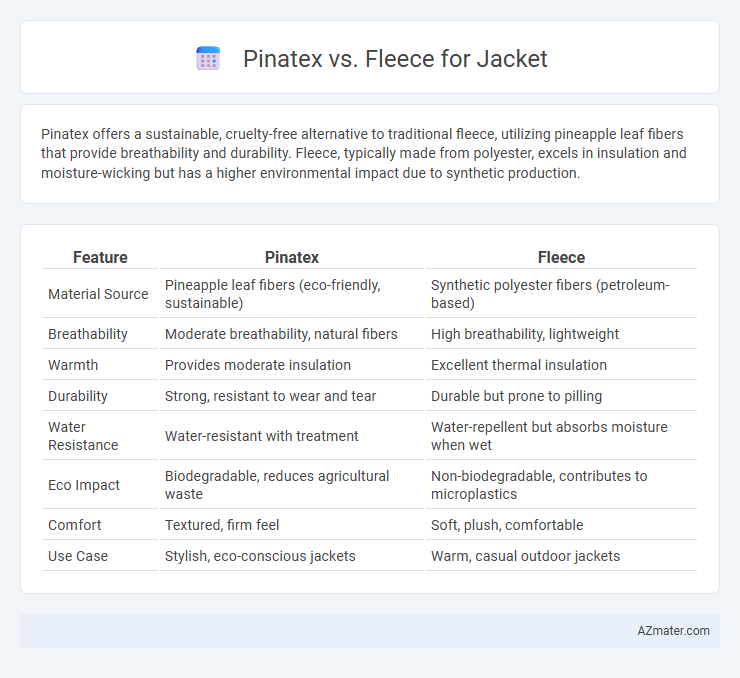Pinatex offers a sustainable, cruelty-free alternative to traditional fleece, utilizing pineapple leaf fibers that provide breathability and durability. Fleece, typically made from polyester, excels in insulation and moisture-wicking but has a higher environmental impact due to synthetic production.
Table of Comparison
| Feature | Pinatex | Fleece |
|---|---|---|
| Material Source | Pineapple leaf fibers (eco-friendly, sustainable) | Synthetic polyester fibers (petroleum-based) |
| Breathability | Moderate breathability, natural fibers | High breathability, lightweight |
| Warmth | Provides moderate insulation | Excellent thermal insulation |
| Durability | Strong, resistant to wear and tear | Durable but prone to pilling |
| Water Resistance | Water-resistant with treatment | Water-repellent but absorbs moisture when wet |
| Eco Impact | Biodegradable, reduces agricultural waste | Non-biodegradable, contributes to microplastics |
| Comfort | Textured, firm feel | Soft, plush, comfortable |
| Use Case | Stylish, eco-conscious jackets | Warm, casual outdoor jackets |
Introduction to Piñatex and Fleece
Pinatex is an innovative sustainable textile made from pineapple leaf fibers, offering an eco-friendly alternative to animal-based materials for jackets. Fleece, a soft synthetic fabric typically made from polyester, is renowned for its lightweight warmth and moisture-wicking properties, widely used in outdoor apparel. Choosing between Pinatex and fleece involves comparing natural origin and biodegradability with synthetic durability and thermal insulation.
Material Origins and Sustainability
Pinatex is an innovative, sustainable fabric made from pineapple leaf fibers, a byproduct of agriculture that reduces waste and supports farmers. Fleece, typically derived from synthetic polyester, relies on petroleum-based resources and often contributes to microplastic pollution during washing. Choosing Pinatex over fleece enhances eco-friendly fashion by utilizing renewable plant-based materials with lower environmental impact and promoting circular economy practices.
Environmental Impact Comparison
Pinatex, made from pineapple leaf fibers, offers a sustainable alternative to traditional fleece by utilizing agricultural waste and reducing landfill contributions. Fleece, primarily produced from petroleum-based polyester, leads to higher carbon emissions and microplastic pollution during laundering. Choosing Pinatex jackets significantly lowers environmental impact through biodegradable materials and reduced reliance on fossil fuels.
Durability and Longevity
Pinatex, made from pineapple leaf fibers, offers exceptional durability with natural resistance to wear, making it an eco-friendly alternative to synthetic materials. Fleece, typically constructed from polyester, provides good longevity due to its synthetic composition but may degrade faster under continuous abrasion compared to Pinatex. When prioritizing durability and longevity, Pinatex jackets maintain structural integrity longer with proper care, while fleece excels in lightweight comfort and insulation.
Comfort and Breathability
Pinatex jackets offer enhanced breathability due to their natural pineapple leaf fibers, allowing better air circulation and moisture management compared to traditional fleece. Fleece provides superior warmth and softness but can trap heat and reduce airflow, making it less comfortable in warmer conditions. The sustainable Pinatex material balances durability with ventilation, ideal for eco-conscious consumers seeking breathable outerwear.
Insulation and Warmth
Pinatex jackets offer moderate insulation derived from natural pineapple leaf fibers, providing breathability and sustainability but less heat retention compared to fleece. Fleece jackets excel in warmth due to their synthetic polyester structure, designed to trap heat efficiently and wick moisture away. Choosing between Pinatex and fleece depends on balancing eco-friendly materials with superior thermal insulation performance.
Aesthetic Appeal and Style
Pinatex offers a unique, natural texture with a matte finish derived from pineapple leaf fibers, appealing to environmentally conscious consumers seeking sustainable fashion with an artisanal touch. Fleece delivers a soft, plush look known for casual comfort and sporty aesthetics, often favored in activewear and outdoor jackets for its warmth and lightweight feel. Choosing between Pinatex and fleece depends on whether the style priority is rustic sophistication or cozy, functional casualness.
Care and Maintenance
Pinatex jackets require gentle cleaning with a damp cloth and mild soap to maintain their natural pineapple fiber texture, avoiding excessive water or harsh chemicals to prevent damage. Fleece jackets are machine washable and dry quickly, but frequent washing can lead to pilling and reduced insulation, so using a gentle cycle and air drying is recommended. Both materials benefit from avoiding high heat during drying to preserve fabric integrity and extend jacket lifespan.
Price and Accessibility
Pinatex jackets typically range from $150 to $300, offering a sustainable alternative made from pineapple leaf fibers, but availability is limited to specialty eco-friendly brands and markets. Fleece jackets, priced between $30 and $100, provide widespread accessibility at major retailers and are favored for affordability and easy maintenance. Consumers prioritizing budget and convenience often choose fleece, while those seeking eco-conscious options pay a premium and navigate more restricted purchasing channels.
Choosing the Right Material for Your Jacket
Pinatex, a sustainable alternative made from pineapple leaf fibers, offers excellent breathability and environmental benefits compared to traditional fleece. Fleece excels in warmth and moisture-wicking, making it ideal for cold, wet conditions but relies on synthetic fibers that impact sustainability. Choosing the right jacket material depends on prioritizing eco-friendliness with Pinatex or maximizing thermal insulation and quick-drying performance with fleece.

Infographic: Piñatex vs Fleece for Jacket
 azmater.com
azmater.com